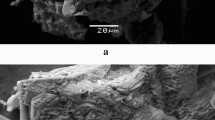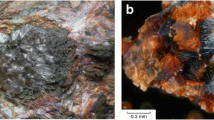Abstract
Zinclipscombite, a new mineral species, has been found together with apophyllite, quartz, barite, jarosite, plumbojarosite, turquoise, and calcite at the Silver Coin mine, Edna Mountains, Valmy, Humboldt County, Nevada, United States. The new mineral forms spheroidal, fibrous segregations; the thickness of the fibers, which extend along the c axis, reaches 20 μm, and the diameter of spherulites is up to 2.5 mm. The color is dark green to brown with a light green to beige streak and a vitreous luster. The mineral is translucent. The Mohs hardness is 5. Zinclipscombite is brittle; cleavage is not observed; fracture is uneven. The density is 3.65(4) g/cm3 measured by hydrostatic weighing and 3.727 g/cm3 calculated from X-ray powder data. The frequencies of absorption bands in the infrared spectrum of zinclipscombite are (cm−1; the frequencies of the strongest bands are underlined; sh, shoulder; w, weak band) 3535, 3330sh, 3260, 1625w, 1530w, 1068, 1047, 1022, 970sh, 768w, 684w, 609, 502, and 460. The Mössbauer spectrum of zinclipscombite contains only a doublet corresponding to Fe3+ with sixfold coordination and a quadrupole splitting of 0.562 mm/s; Fe2+ is absent. The mineral is optically uniaxial and positive, ω = 1.755(5), ɛ = 1.795(5). Zinclipscombite is pleochroic, from bright green to blue-green on X and light greenish brown on Z (X > Z). Chemical composition (electron microprobe, average of five point analyses, wt %): CaO 0.30, ZnO 15.90, Al2O3 4.77, Fe2O3 35.14, P2O5 33.86, As2O5 4.05, H2O (determined by the Penfield method) 4.94, total 98.96. The empirical formula calculated on the basis of (PO4,AsO4)2 is (Zn0.76Ca0.02)Σ0.78(Fe 3+1.72 Al0.36)Σ2.08[(PO4)1.86(AsO4)0.14]Σ2.00(OH)1. 80 · 0.17H2O. The simplified formula is ZnFe 3+2 (PO4)2(OH)2. Zinclipscombite is tetragonal, space group P43212 or P41212; a = 7.242(2) Å, c = 13.125(5) Å, V = 688.4(5) Å3, Z = 4. The strongest reflections in the X-ray powder diffraction pattern (d, (I, %) ((hkl)) are 4.79(80)(111), 3.32(100)(113), 3.21(60)(210), 2.602(45)(213), 2.299(40)(214), 2.049(40)(106), 1.663(45)(226), 1.605(50)(421, 108). Zinclipscombite is an analogue of lipscombite, Fe2+Fe 3+2 (PO4)2(OH)2 (tetragonal), with Zn instead of Fe2+. The mineral is named for its chemical composition, the Zn-dominant analogue of lipscombite. The type material of zinclipscombite is deposited in the Mineralogical Collection of the Technische Universität Bergakademie Freiberg, Germany.
Similar content being viewed by others
References
S. B. Castor and G. C. Ferdock, Minerals of Nevada (Nevada Bureau Mines and Geol. Spec. Publ., 2004).
F. Čech, K. Paděra, and P. Povondra, “Lipscombite from Pegmatites at Otov Near Domažlice (Bohemia, Czechoslovakia),” Acta Univ. Carolinae Geol., No. 3, 171–191 (1961).
M. A. Gheith, “Lipsocombite, a New Synthetic ‘Iron Lazulite,’” Am. Mineral. 38, 612–638 (1953).
M. L. Lindberg, “Manganoan Lipsombite from the Sapucaia Pegmatite Mine, Minas Gerais, Brazil. First Occurrence of Lipsocombite in Nature,” Am. Mineral. 47, 353–359 (1962).
J. A. Mandarino, “The Gladstone-Dale Relationship: Part IV. The Compatibility Concept and Its Application,” Can. Mineral. 19, 441–450 (1981).
J. A. Mandarino and M. Back, Fleischer’s Glossary of Mineral Species (Mineral Rec. Inc., Tucson, 2004).
J. Staněk, “Studium sekudárních fosfát ů železa a mangany z pegmatite od Cyrilova,” Folia (Geologia) 12(9), 25–48 (1971).
I. Vencato, E. Mattievich, and Y. P. Mascarenhas, “Crystal Structure of Synthetic Lipscombite: A Redetermination,” Am. Mineral. 74, 456–460 (1989).
R. Vochten and E. de Grave, “Crystallographic, Mössbauer, Electrokinetic Study of Synthetic Lipscombite,” Phys. Chem. Miner. 7, 197–203 (1981).
R. Vochten, P. van Aker, and E. de Grave, “Mössbauer, Electrokinetic and Refined Lattice Parameters Study of Synthetic Manganoan Lipscombite,” Phys. Chem. Miner. 9, 263–268 (1983).
Author information
Authors and Affiliations
Corresponding author
Additional information
Original Russian Text © N.V. Chukanov, I.V. Pekov, S. Möckel, A.E. Zadov, V.T. Dubinchuk, 2006, published in Zapiski Rossiiskogo Mineralogicheskogo Obshchestva, 2006, Pt CXXXV, No. 6, pp. 13–18.
Considered by the Commission on New Minerals and Mineral Names, Russian Mineralogical Society, January 16, 2006. Approved by the Commission on New Minerals and Mineral Names, International Mineralogical Association, May 1, 2006.
Rights and permissions
About this article
Cite this article
Chukanov, N.V., Pekov, I.V., Möckel, S. et al. Zinclipscombite, ZnFe 3+2 (PO4)2(OH)2, a new mineral species. Geol. Ore Deposits 49, 509–513 (2007). https://doi.org/10.1134/S1075701507070033
Received:
Issue Date:
DOI: https://doi.org/10.1134/S1075701507070033




